工程力学英文版课件07 Stress for Axial Loads
- 格式:ppt
- 大小:947.50 KB
- 文档页数:39
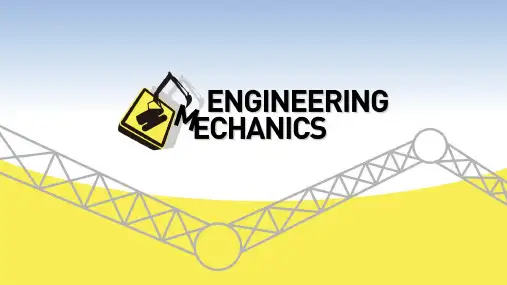
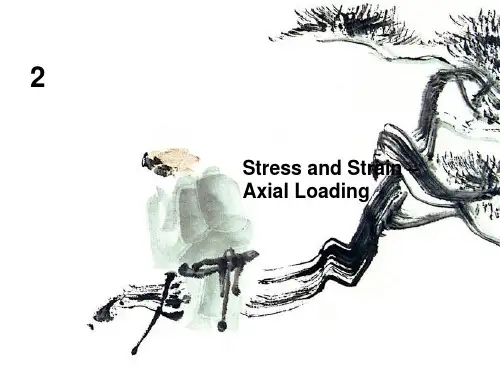
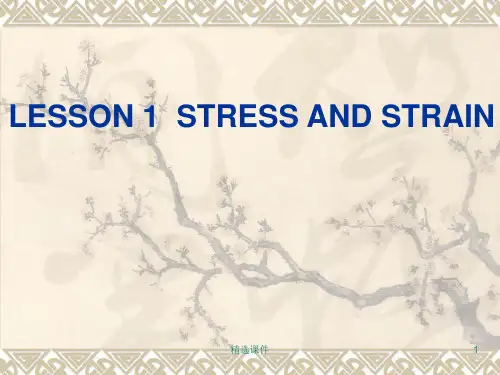
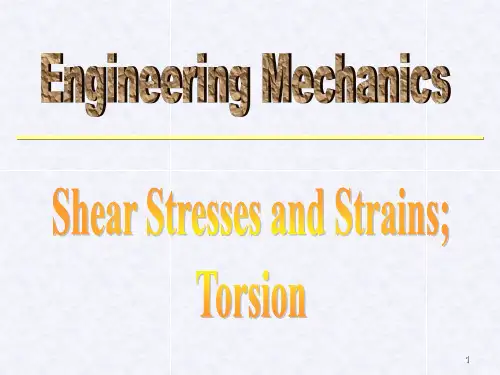
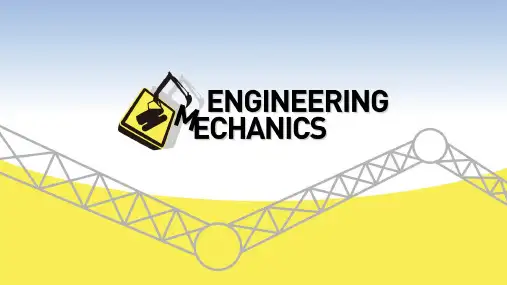
Part II:Mechanics of MaterialsTorsionStudy object: A long straight member subjected to a torsional loading •How to determine the stress distribution?•How to determine the angle of twist?•Statically indeterminate analysis of the member in torsion?Torsion:If a member is subjected to the action of a pair of moments which are of a common magnitude and opposite senses,and lie in planes perpendicular to the longitudinal axis,the member is said to be in torsion.Screwdriver bar Transmission shaftTorque: a moment that tends to twist a member about its longitudinal axis. Shaft: a member that deforms mainly in torsion.Assumptions :•The cross section remains a plane,and the size and shape remain the same (a rigid plane).•The cross section rotates about the longitudinal axis through an angle.The small element on the surface is under pure shear:By observation :Longitudinal lines : remain straight , twisted angle;the length of shaft remains unchangedRadial lines : remain straight and rotate about the center of the cross sectionCircumferential lines : remain the same and rotate about the longitudinal axis TORSIONAL DFORMATION OF A CIRCULAR SHAFT t M tMAngle of twist : the relative angular displacement between two cross-sections,()x φ The angle of twist varies linearly with x .()x φφ∆The angle of twist of the back face: ()x φThe angle of twist of the front face: ()x φφ+∆causes the element to be subjected to a shear strain.Isolate an element from the shaft After deformation Before deformationIf andx dx ∆→d φφ∆→Since and are the same for all points on the cross section at x dφdxThe shear strain within the shaft varies linearly along any radial line from zero to .max γρd constant dx φ=at a specific position x c cdx d ///max γργφ==max γργ⎪⎭⎫ ⎝⎛=cImportant points (review)☐Assumptions:for a shaft with a circular cross section subjected to a torque.•The cross-section remains a plane•The length of the shaft and its radius remain unchanged•Its radial lines remain straight and circles remain circular☐The shear strain varies linearly along any radial line.r If the material is linear-elastic, then Hooke’s law applies, G τγ=A linear variation in shear strain leads to a corresponding linear variation in shear stress . The integral depends only on the geometry of the shaft.2max max A T dA J c c ττρ==⎰Polar moment of inertia max ()()A A T dA dA c ρρτρτ==⎰⎰Each element of area located at ,is subjected to aforce of .The resultant internal torque producedby this force is dA ρ()dT dA ρτ=()dF dA τ=TORSIONAL FORMULAmax γργ⎪⎭⎫ ⎝⎛=c max τρτ⎪⎭⎫ ⎝⎛=cT J ρτ=wheremaxτT :c :J :Torsional formulaPolar moment of inertia()cc A cd d dA J 0403022)41(222ρπρρπρπρρρ⎰⎰⎰====42c J π=Note: J is a geometric property of the circular area and is always positive. The commonunit is mm 4Solid shaft Tubular shaft ()4402i c c J -=πO 2cρρd d 2d =A O 2c i 2c 0ρρdThe internal torque T develops a linear distribution of shear stress along each radial line in the plane of the cross-section,it also develops an associated shear-stress distribution along an axial plane.Why?T Jρτ=The internal torque T develops a linear distribution of shear stress along each radial line in the plane of the cross-section,it also develops an associated shear-stress distribution along an axial plane.Why?(complementary property of shear stress))(x TAbsolute Maximum Torsional Stress of a shaft -A torque diagramThis diagram is a plot of the internal torque T versus its position x along the shaft length. Sign convention: By right-hand rule, if the thumb directs outward from the shaft, then the internal torque is positive.The Procedure of Analysis to determine the shear stress for a shaft under torsion1. Internal Loading (Torque)Section the shaft perpendicular to its axis at the point where the shear stress is to be e free-body diagram and the equilibrium equations to obtain the internal torque.2. Cross Section Properties (Polar moment of inertia )3. Shear Stress Distribution (Torsional formula)T J ρτ=42c J π=()4402i c c J -=πJTc =max τThe shaft is supported by two bearings and is subjected to three torques. Determine the shear stress developed at point A and B , located at section a-a of the shaft.Example 1ABInternal Torque.The bearing force reactions on the shaft are zero, since the applied torques satisfy moment equilibrium about the shaft’s axis.The free body diagram of the left segment.mkN T T m kN m kN M x ⋅==-⋅-⋅=1250030004250 ;0∑ABmkN T ⋅=1250AB Cross Sectional Property. The polar moment of inertia for the shaft is 474 )10(97.4) 75(2mm mm J ==πShear Stress. Since point A is at ρ=c = 75 mm and point B at ρ= 15 mmGPa mm kN mm mm m kN J Tc A 89.1/89.1)10(97.4)75)(1250(247==⋅==τGPa mmmm m kN J T B 377.0)10(97.4)15)(1250(47=⋅==ρτAns.Important points (review)☐For a linear elastic homogenous material, the shear stress along any radial line of the shaft varies linearly from zero to a maximum value at the outer surface.☐The shear stress is also linearly distributed along an adjacent axial plane of the shaft due to the complementary property of shear stress.☐Torsional formula:valid for a shaft with circular cross-section and made of homogenous material with a linear-elastic behavior.Deformation of the shaftdxd γφρ=(linear elastic material)d dxρφγ=)(/)(x J x T ρτ=Gx J x T )(/)(ργ=γτG =dxGx J x T d )()(=φANGLE OF TWISTdxGx J xT d )()(=φIntegrating over the entire length L of the shaft,⎰=Ldx Gx J x T 0)()(φTORSIONJGTL =φ∑=JGTL φConstant Torque and Cross-Sectional Area⎰=L dx Gx J x T 0)()(φ⎰=Ldx E x A x P 0)()(δAEPL =δ(Axially loaded bar)TTT 2T 1T 3Sign ConventionRight-hand rule,the torque and angle will be positive,provided the thumb is directed outward from the shaftTo determine the angle of twist of one end of a shaft with respect to the other end:1. Internal Loading (Torque)•The method of section and the equation of moment equilibrium2. Angle of Twist•The polar moment of inertia J (x );•or •A consistent sign convention for the shaftGdx x J x T )(/)(⎰=φJG TL /=φ✓If the torque varies continuously along the shaft’s length, a section should be made at the arbitrary position, T (x )✓If several constant external torques exist, the internal torques in each segment between any two external torques much be determined (a torque diagram)The Procedure of AnalysisExample 2The two solid steel shafts shown are coupled together using the meshed gears. Determine the angle of twist of end A of the shaft AB when the torque T=45N·m is applied.G=80GPa.Shaft AB is free to rotate within bearing E and F,whereas shaft DC is fixed at D.Each shaft has a diameter of20mm.1. Internal Torque. F ree body diagrams of the shafts are shown in figures. Step 1:Solution300Nm 150.0m/45N m 150.0/,0m 150.00=⋅===⨯-→=∑T F F T MABx ()()mN 5.22m 075.0N 003m 075.0,0-m 075.00⋅=⨯=⨯==⨯=F T T F Mx D x D CDx ∑→2. Angle of Twist.To solve the problem, we need to calculate the rotation of gear C with respect to the fixed end D in shaft DC .rad 0269.0]N/m )10(80[)m 010.0)(2/()m 5.1)(m N 5.22(294/+=⋅+==πφJG TL DC DC Since the two gears are in mesh, of gear C causes gear B to rotate C φBφrad0134.0 )m 075.0)(rad 0269.0()m 15.0(=→=B B φφm 010.0=c GPa80=GThen we need to determine the angle of twist of end A with respect to end B of shaft AB .The rotation of end A is therefore determined by adding and since bothangles are in the same direction .B φB A /φrad0.0850 rad 0.0716rad 0134.0/+=+=+=B B A A φφφAns.m 010.0=c GPa 80=G rad0134.0 =B φHomework assignments: 5-3, 5-9, 5-27, 5-38,5-58, 5-71()()()()()[]rad 0716.0m/N 1080m 010.02/m 2m N 45294/=⋅+==πϕJG TL AB BAEquilibrium:;0=--=∑B A xT T T MThere are two unknowns, therefore this problem is indeterminate.Compatibility or the kinematic condition: two ends are fixed:/=B A φSTATICALLY INDETERMINATE TORQUE-LOADED MEMBERS=-JGL T JG L T BC B AC A ()BC ACL LL +=⎪⎭⎫⎝⎛=L L T T BC A ⎪⎭⎫ ⎝⎛=L L T T AC B TORSION;0∑==B A xT T T M-- ;0=/BA φThe Procedure of AnalysisTo determine the unknown torques in statically indeterminate shafts:•Equilibrium equationsDraw a free-body diagram of the shaft to identify all internal torques.Write the equations of moment equilibrium about the axis of the shaft.•CompatibilityExpress the compatibility condition in terms of the rotational displacements caused by the reactive torques.•Solving unknownsSolve the equilibrium and compatibility equations for the unknown reactive torques.Pay attention to the sign of the results.Example 3The shaft is made from a steel tube,which is bonded to a brass core.A torque of T=250N·m is applied at its end,plot the shear-stress distribution along a radial line of its cross-section.(G st=80GPa,G br=36GPa)Solution:Equilibrium. A free-body diagram of the shaft . The reaction has been represented by twounknown amount of torques resisted by the steel, T st and by the brass, T br .m N 250=⋅+--br st T T Compatibility. The angles of twist at fixed end A should be the same for both the steel and brass since they are bonded together .brst φφφ==Applying the load-displacement relationship , , we haveJG TL /=φbrbr br st st st J G LT J G L T =brst T T 33.33=(1)(2)m N 28.7m N 72.242⋅=⋅=⇒br st T TThe shear stress in the brass core varies from zero at its center to the maximum at the interface, using the torsional formulaMPa 63.4mm)/2)(10(mm)mm/m)(10 m)(10N 28.7()(43max =⋅==πτbr br br J c T For the steel, the minimum shear stress is at this interfaceMPa 30.10])mm 10(mm) /2)[(20(mm) mm/m)(10 m)(10N 72.242()(443min=-⋅==πτst inner st st J c T The maximum shear stress is at the outer surfaceMPa 630.20])mm 10(mm) /2)[(20(mm)mm/m)(20 m)(10N 72.242()(443max =-⋅==πτst outer st st J c Tm N 28.7mN 72.242⋅=⋅=br st T Trad )10(1286.0N/mm)10(36N/mm 63.43232-===G τγAns.Homework assignments: 5-75, 5-82, 5-85The shear stress is discontinuous at the interface because the materials have different moduli .The stiffer material (steel)carries more shear stress.However,the shear strain is continuous at the interface.Shear strain at the interface:MPa63.4)(max =br τMPa30.10)(min =st τMPa630.20)(max =st τ。
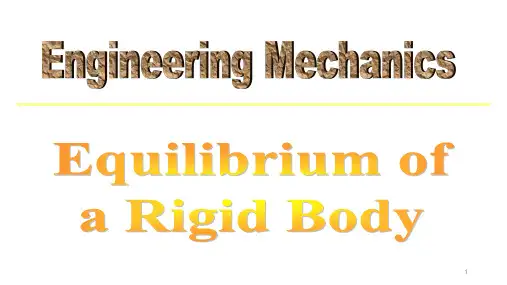
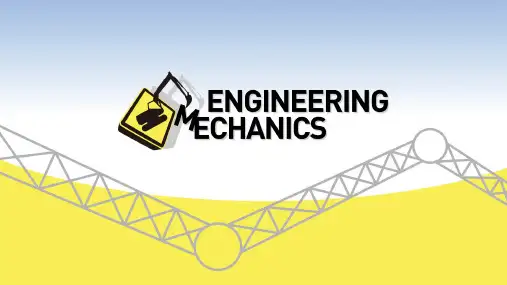
Part II:Mechanics of Materials Combined loadingsCOMBINED LOADINGSObjects of the section:•To analyze the stresses in thin-walled pressure vessels•To develop methods to analyze the stress in members subject to combined loadings(e.g. tension or compression, shear, torsion, bending moments).“Thin wall ”: A vessel having an inner-radius-to-wall-thickness ratio of 10 or more (r/t>= 10).The results of a thin-wall analysis will predict a stress that is approximately 4%less than the actual maximum stressIt is assumed that the stress distribution throughout the vessel’s thickness is uniform or constant.Cylindrical Vessels•A pressure p is developed within the vesselby a contained gas or fluid;•An element shown in the figure is assumedto be subjected to normal stress σ1in thecircumferential or hoop direction and σ2inthe longitudinal or axial direction.•Both stress exert tension on the materialPlane stressFor the hoop stress, the vessel is being sectioned by planes a, b and c.The uniform hoop stress σ1, acting throughout the vessel’s wall, the pressure acting the vertical face of the sectioned gas or fluid.10; 2[( )](2 )0x F t dy p r dy σ=-=∑1pr tσ=It can be imagined as the solidvertical face with p acting.For the axial stress, the vessel is being sectioned by the plane b .The uniform axial stress σ2, acting throughout the vessel’s wall, the pressure p acting the section of gas or fluid. It is assumed that the mean radius r is approximately equal to the vessel’s inner radius.220; (2)()0y Frt p r σππ=-=∑2pr σ=It can be imagined asthe solid section facewith p acting.1pr t σ=22pr tσ=σ1, σ2= the normal stress in the hoop and longitudinal directions, respectively. Each is assumed to be constant throughout the wall of the cylinder, and each subjects the material to tension .p = the internal pressure developed by the contained gas or fluidr = the inner radius of the cylindert = the thickness of the wall (r/t >=10)Spherical Vessels•A pressure p is developed within the vesselby a contained gas or fluid;•An element shown in the figure is assumedto be subjected to normal stress σ2, whichexerts tension on the material.the vessel is sectioned in half using section plane a. Equilibrium in y direction requires:220; (2)()0y F rt p r σππ=-=∑22pr t σ=It can be imagined asthe solid section facewith p acting.THIN-WALLED PRESSURE VESSELS☐Either a cylindrical or a spherical vessel is subjected to biaxial stress.☐The material of the vessel is also subjected to a radial stress σ3, which acts along a radial line. The maximum of it equals to p at the interior wall and decreases to zero at the exterior wall.☐The radial stress σ3will be ignored because σ1and σ2are 5 to 10 times higher than σ3.☐External pressure might cause the vessel to buckle.A member is subjected either an internal axial force, a shear force, a bending moment, or a torsional moment.Several these types of loadings are applied to the member simultaneouslyPrinciple of SuperpositionResultant stress distribution caused by the loads.•A linear relationship exists between the stress and the loads •The geometry of the member should not undergo significant changeAssumptions STATE OF STRESS CAUSED BY COMBINED LOADINGSThe Procedure of Analysisto determine the resultant stress distribution caused by combined loadingsInternal Loadings•Section the member perpendicular to its axis at the point where the stress to be determined and obtain N,M,V and T.•The force components should act through the centroid of the cross section and the moment components should be computed about the centroidal axes .Average Stress Components•Compute the stress component associated with each internal loading.(Distribution of stress acting over the entire cross-sectional area or the stress at a specific point)How?(The neutral axis)NORMAL FORCE P SHEAR FORCE V BENDING MOMENT TORSIONAL MOMENT or THIN-WALLED PRESSURE VESSELS: and SuperpositionOnce the normal and shear stress components for each loadings have beencalculated, use the principle of superposition and determine the resultant normal and shear stress components.x P Aσ=VQ Itτ=y z x z yM z M y I I σ=-+T Jρτ=2m T A t τ=1pr tσ=22pr t σ=Important points (review)☐Pressure vessels: For a thin wall cylindrical pressure vessel with r/t >= 10; the hoop stress is σ1= pr/t. The longitudinal stress is σ2= pr/2t.☐For a thin wall spherical vessels having the same normal tensile stress, which is σ= σ2 = pr/2t.1☐Superposition of stress components: The procedure to analyze the stress state ofa point for a member, which is subjected to a combined loading.Homework assignments: 8-5, 8-15, 8-21, 8-41, 8-54Example 1A force of 15000 N is applied to the edge of the member shown below. Neglect the weight of the member and determine the state of stress at pointsB and C.Solution:1. Internal Loadings. It is sectioned through B and C. For equilibrium at the section, the internal loadings is shown below.2. Stress Components.Normal Force: 150003.75MPa (100)(40)P A σ===Bending moment: The normal force distribution due to bending moment is shown below. 33(40)(100)1212bh I ==N A315000(50)11.25MPa (112)(40)(100)B B My I σ-=-=-=315000(50)11.25MPa (112)(40)(100)c c My I σ=-=-=-yz3. Superposition 3()15000(50)( 3.75)7.5 MPa (112)(40)(100)B B My P I A σ--=-+=-+-=(tension)3()15000(50)( 3.75)15 MPa (112)(40)(100)c c My P I A σ-=-+=-+-=-(compression)Example 2The member shown has a rectangular cross section. Determine the state of stress that the loading produces at point C.Solution:AB F Ax = 16.45 kN; F Ay = 21.93 kN; F B = 97.59 kN1. Internal Loadings. The support reactions on the member have been determined and shown. (Using the equations of equilibrium for the whole member)After the support reactions have known,the internalloadings at section C have been determined and shownin the right figure.2. Stress Components.Normal Force: Shear Force: C C C C It y A V It VQ ''==τSince A= 0, thus Q C = 0, τC = 0 MPa 32.1)250.0)(050.0(45.16===A N C σBending moment: Point C is located aty = c = 125 mm from the neutral axis,so the normal stress at C.MPa 15.63)250.0)(050.0(121)125.0)(89.32(3=⎥⎦⎤⎢⎣⎡==I Mc C σσC =63.15 MPa3. SuperpositionMPa 5.6415.6332.1=+=C σAns.。
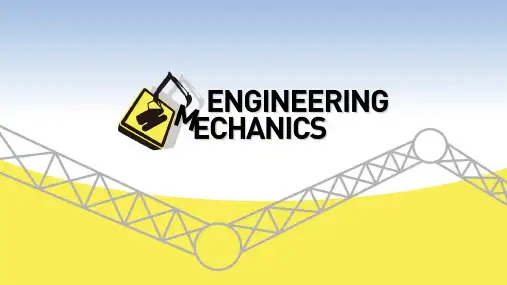
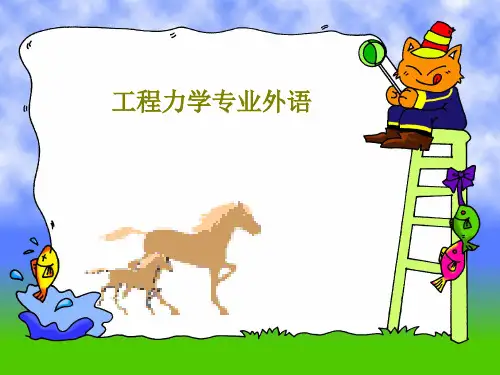
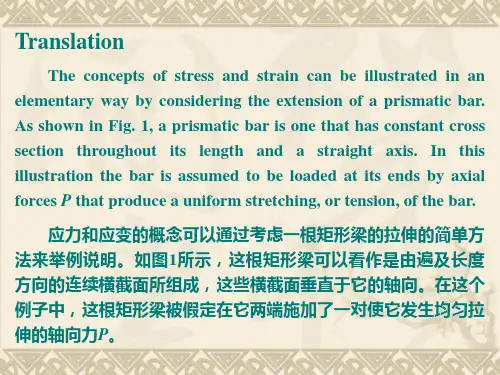

Part II:Mechanics of Materials Transverse shearSHEAR IN STRAIGHT MEMBERS•Shear forces (V)and bending moments (M)are developed generally in beams.Internal force and moment•The shear V is the result of a transverse shear-stress distribution over the beam’s cross section.Due to the complementary property ofthe shear, associated longitudinal shearstresses will also act along longitudinalplanes of the beam.Due to the complex shear stress, shear strains will be developed and these will tend to distort the cross section.The cross section of the beam under a shear V will warp,not remain plane.All cross sections of the beam remain plane and perpendicular to the longitudinal axis. –the assumption for the flexure formulaAlthough the assumption is violated when the beam is subjected to bending moment and shear force, the warping is small enough to be neglected.A slender beam'''''0; ' ()0 () -()()0 ()x A A A A A F dA dA tdx M dM M ydA ydA tdx II dM ydA tdx I σστττ+=--=+-=⎛⎫= ⎪⎝⎭∑⎰⎰⎰⎰⎰⎰=')(1A ydA dx dM It τ'''''0; ' ()0 () -()()0 ()x A A A A A F dA dA tdx M dM M ydA ydA tdx II dM ydA tdx I σστττ+=--=+-=⎛⎫= ⎪⎝⎭∑⎰⎰⎰⎰⎰⎰=')(1A ydA dx dM It τ'''''0; ' ()0 () -()()0 ()x A A A A A F dA dA tdx M dM M ydA ydA tdx II dM ydA tdx I σστττ+=--=+-=⎛⎫= ⎪⎝⎭∑⎰⎰⎰⎰⎰⎰=')(1A ydA dx dM It ττ⎰=')(1A ydA dx dM It τItVQ =τ=the shear stress at the point located a distance y’ from the neutral axis V =the internal result shear forceI =the moment of inertia of the entire cross-sectional area computed about theneutral axist = the width of the member’s cross -sectional area, measured at the point where is to be determined'''A y ydA Q A ==⎰Shear formulaIt applies to determine transverse shear stress in the beam’s cross -sectional area ττ'''A y ydA Q A ==⎰Area =A '9Rectangular Cross Section b y h b y h y h y A y Q )4(21 )2()2(2122-=-⎥⎦⎤⎢⎣⎡-+=''=b bh b y h V It VQ )121(])4/)[(21(322-==τ)4(6223y h bh V -=τ•The maximum value •The position SHEAR STRESS IN BEAMS , 02h y τ=±=max 0, 1.5V y Aτ==Rectangular Cross SectionV h h h h h h V y y h h V bdy y h bh V dA h h h h A =+-+=-=-=--⎰⎰)]88(31)22(4[6 ]314[6 )4(6 33232/2/3232/2/223τmax 0, 1.5V y Aτ==Circular cross section2342233max r r r Q yA ππ⎛⎫⎛⎫=== ⎪ ⎪⎝⎭⎝⎭44r I π=2b r =Hollow circular cross section()332123max Q yA r r ==-()44214I r r π=-212()b r r =-•The shear stress varies parabolically•The shear stress will vary only slightlythroughout the web•A jump occurs at the flange-web junction. Shear stress?Direction?WhyWeb-Flange BeamLimitations on the Use of the shear FormulaAssumption of the shear formula: the shear stress is uniformly distributed overthe width b at the section.max τ'is only about 3% greater than , which represents the average maximum shear stress.ItVQ =max τ•The shear stress at the flange-webjunction is not accurate due to stressconcentration.•The inner regions of the flanges arefree boundaries, however the shearstress determined by the shear formulais not equal to zeroThese limitations are not important since most engineers need to calculate the average maximum shear stress, which occurs at the neutral axis, where b/h ratio is very small.to determine the shear stress distribution with the shear formula.•Section the member perpendicular to its axis at the point where the shear stress to be determined.Internal Shear Force, V(x)Section Property•Determine the location of the neutral axis , the moment of inertia I about the neutral axis;•Imagine a horizontal section through the point where the shear stress is to be determined. Measure the width t of the area at this section.•where is the distance to the centroid of measured from the neutral axis. A y A d y Q A ''='=⎰'y 'The Procedure of AnalysisA '16Shear Stress •It VQ =τThe beam shown in the figure is made of wood and is subjected to a resultant internal vertical shear force V = 3 kN.(a) Determine the shear stress in the beam at point P and(b) compute the maximum shear stress in the beam.Example 1Part (a).Section property. The moment of inertia of the cross-sectional area computed about the neutral axis is 463mm 1028.16)125)(100(121121⨯===bh I 34mm 1075.18 )100)(50)](50(215.12[⨯=+=''=A y Q Shear stressMPa 346.0kN/mm 1046.3 )100)(1028.16()1075.18)(3(2464=⨯=⨯⨯==-It VQ P τAns.A horizontal section line is draw through point P andthe partial area A’ is shown SolutionPart (b).Section property. The maximum shear stress occurs at the neutral axis, since t is constant throughout the cross section and Q is largest for this case. For the dark shaded area A’, we have34mm 1053.19)5.62)(100(25.62⨯=⎥⎦⎤⎢⎣⎡=''=A y Q Shear stress. Applying the shear formula yields:MPa360.0kN/mm 1060.3 )100)(1028.16()1053.19)(3(2464max =⨯=⨯⨯==-It VQ τNote that this is equivalent to MPa 36.0kN/mm 106.3)125)(100(35.15.124max =⨯===-A V τ☹The members having short or flat cross sections (The shear stress is not uniform across the width)☹At points where the cross section suddenly changes ☹The edge of the cross section does not parallel to the y axis. yVSHEAR STRESS IN BEAMS。